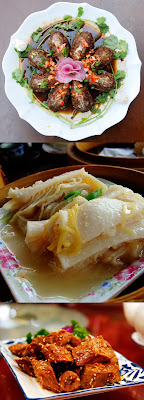![]()
 The city 大同 (Dàtóng) in 山西 (Shānxī) Province has a rabbit head street. It’s lined with 兔头 (tù tóu, rabbit head) (pictured on the left, top) restaurants that offer up the local specialty at different levels of spiciness. I felt a bit grossed out by the huge barrels of cooked rabbit heads sitting out on the street in front of the restaurants, but curiosity eventually overcame me and I ended up going in and ordering a couple of spicy rabbit heads. I sat down not really knowing how to approach eating a rabbit head. My friend showed me how it’s done: first you gnaw the meat off the cheek areas, then grab the mandibles and crack it open so you can bite out the tongue, and the final touch if you are really hardcore is to bite into the top of the head and suck out the brain.
The city 大同 (Dàtóng) in 山西 (Shānxī) Province has a rabbit head street. It’s lined with 兔头 (tù tóu, rabbit head) (pictured on the left, top) restaurants that offer up the local specialty at different levels of spiciness. I felt a bit grossed out by the huge barrels of cooked rabbit heads sitting out on the street in front of the restaurants, but curiosity eventually overcame me and I ended up going in and ordering a couple of spicy rabbit heads. I sat down not really knowing how to approach eating a rabbit head. My friend showed me how it’s done: first you gnaw the meat off the cheek areas, then grab the mandibles and crack it open so you can bite out the tongue, and the final touch if you are really hardcore is to bite into the top of the head and suck out the brain.
 After taking the initial plunge and eating rabbit heads, I felt inspired to try a bunch of other strange foods. Some of the ones that I ended up trying include: pig’s feet, chicken’s feet, goose feet, duck neck (pictured on the left, bottom), duck tongue, cow brain, cow stomach (pictured on the left, middle), fish flotation bladder, donkey meat hotpot, stinky tofu, and dog meat. Some of the ones I still haven’t tried include: roasted scorpions on a stick and drunken shrimp. If you subscribe to Chinesepod you can check out a great advanced lesson on strange Chinese foods, 古怪食物
After taking the initial plunge and eating rabbit heads, I felt inspired to try a bunch of other strange foods. Some of the ones that I ended up trying include: pig’s feet, chicken’s feet, goose feet, duck neck (pictured on the left, bottom), duck tongue, cow brain, cow stomach (pictured on the left, middle), fish flotation bladder, donkey meat hotpot, stinky tofu, and dog meat. Some of the ones I still haven’t tried include: roasted scorpions on a stick and drunken shrimp. If you subscribe to Chinesepod you can check out a great advanced lesson on strange Chinese foods, 古怪食物
At some point during my first month in China I came up with a special ordering strategy: I would only order things on the menu with names I didn’t understand. The process was surprising, hit or miss, and a whole lot of fun. Sometimes I knew the meaning of the food names on the menu character-by-character without knowing the combined meanings. For example, at one of my first meals I decided to order 牛白叶 (niú bái yè), which sounded harmless to me. The name looked like “Cow white leaf”. I thought to myself, “sounds like a beef dish with some exotic vegis on the side”. For my 饮料 (yǐnliào, drink) I ordered 雪碧 (xuěbì) which I understood character-by-character to mean “Snow Jade”. So I thought to myself, “sounds like an exotic island style mixed drink.” My little pocket dictionary didn’t have 雪碧 as an entry so I was clueless as to the combined meaning. I was pretty surprised when the waiter brought out my meal which consisted of a plate of cow stomach (pictured on the left, middle) and a sprite!
You probably already know if you’ve ordered food at a 地道 (dìdao, authentic) Chinese restaurant that Chinese menus are difficult to get a handle on because of the huge variety of foods and local specialties. A good way to start working on reading Chinese menus is to first learn the general menu categories. You’ll often see 肉类 (ròu lèi, meat category),蔬菜 (shūcài, vegetables),汤 (tāng, soups),饮料 (yǐnliào, drinks),主食 (zhǔshí, staple food). The 主食 is usually rice, noodles, or 馒头 (mántou, steamed buns). In 山西 where I lived the 主食 was usually served last in the meal when I would usually be feeling completely stuffed from all of the other food. It might also be helpful to add some general food vocabulary to your skritter study program. I’d recommend this custom list: How To Order Chinese Food (Ordering Guides) provided by Skritter user Lyons.
So for all of you skritter users out there – I’m wondering what strange foods have you all tried in China? Does anyone have other tips for getting started with Chinese menu reading?
